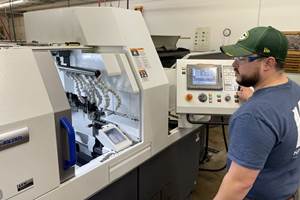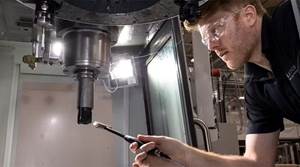Connect, Monitor and Be Prepared
Real-world applications chart a three-step course for CNC machining operations that have yet to realize the promise of data-driven manufacturing.
Share






Industry 4.0. Industrial Internet of Things. Factory of the future. Digital thread. Such terms define a supposed new era in manufacturing, and industry events like the International Manufacturing Technology Show () buzz with discussion of smart machine tools, smart robots, smart gages and smart everything. However, many terms in this heady new lexicon can seem meaningless for CNC machine shops.
Make no mistake: There is real promise for machining businesses in an era when seemingly anything can have an IP address. Application stories published in 91±¬ÁĎÍř prove that. The stories also prove that a shop doesn’t have to meet anyone’s grandiose definition of a “smart factory” to base decisions on real-world evidence, and that is the essence of data-driven manufacturing. The reason for the revolution is that we can now act on evidence that would be unknowable or inherently outdated without the capability to pull data directly from shopfloor equipment. Taken as a whole, our coverage indicates that those hoping to join in have three essential tasks ahead: to connect, to monitor and to be prepared.
To connect is to build a network; that is, to interlink a shop’s machine tools and other manufacturing devices. This first step can be challenging in a facility with a variety of equipment from various eras and various manufacturers. We might not have recognized it at the time, but our deeper coverage of data-driven manufacturing began with that challenge about 10 years ago—specifically, with a series of articles about MTConnect. Penned by Mark Albert, former editorial director and longtime mentor to yours truly, these pieces explored the development and the application of this standard communications protocol for CNC machine tools and other manufacturing equipment.
Step two is leveraging those connections to monitor the status and health of machine tools and other equipment on the floor. In 2016, Mark reported on how a manufacturer of specialty valves and accessories had significantly increased productivity and machine uptime despite being in the earliest stages of implementing a monitoring system that shed light on, among other metrics, the shop’s overall equipment efficiency (OEE) rating. This past April, he reported on a contract operation that realized more unexpected gains from its newly acquired shopfloor data: strengthening and fine-tuning its employee incentive program.
This unexpected advantage brings us to the third step: be prepared. A shop’s motivation for moving toward data-driven manufacturing should not be limited to advantages that can be envisioned now. Many of the most important gains will be difficult to foresee at the outset. Implementing data-driven manufacturing is also an exercise in ensuring a shop is prepared—that it has the infrastructure in place to take advantage of whatever comes next.
What comes next will be a primary focus of this column. That’s not to suggest we won’t discuss the first two steps, machine monitoring and machine interconnection. Both will be prime fodder for discussion here. However, so will developments that might not seem applicable to CNC machining, or at least not at first. Advances in virtual and augmented reality, artificial intelligence, advanced simulation and other new technologies likely will impact machine shops in time. They are already seeking and finding roles in other manufacturing applications.
Perhaps one of the technologies highlighted here will spur an idea for innovation in your own shop. Perhaps you’ll be the one to show all of us the promise of that technology for CNC machining, and the future we were preparing for when we first began to connect. Maybe we’ll even pay you a visit.
Related Content
ERP Provides Smooth Pathway to Data Security
With the CMMC data security standards looming, machine shops serving the defense industry can turn to ERP to keep business moving.
Read More5 Tips for Running a Profitable Aerospace Shop
Aerospace machining is a demanding and competitive sector of manufacturing, but this shop demonstrates five ways to find aerospace success.
Read MoreHow to Mitigate Chatter to Boost Machining Rates
There are usually better solutions to chatter than just reducing the feed rate. Through vibration analysis, the chatter problem can be solved, enabling much higher metal removal rates, better quality and longer tool life.
Read MoreContinuous Improvement and New Functionality Are the Name of the Game
Mastercam 2025 incorporates big advancements and small — all based on customer feedback and the company’s commitment to keeping its signature product best in class.
Read MoreRead Next
How I Made It: Dennis Rymanowski
Dennis Rymanowski has worked at NSH USA for 60 years, with his passion for manufacturing living alongside his passion for his family’s polka band.
Read MoreA New Frontier in Surface Finish Control
What if your machine tool could measure surface roughness as it cuts? This article explores how in-process metrology is advancing from concept to reality, enabling real-time feedback, immediate detection of anomalies and new levels of control over surface quality. Discover the technologies making this possible.
Read More






















